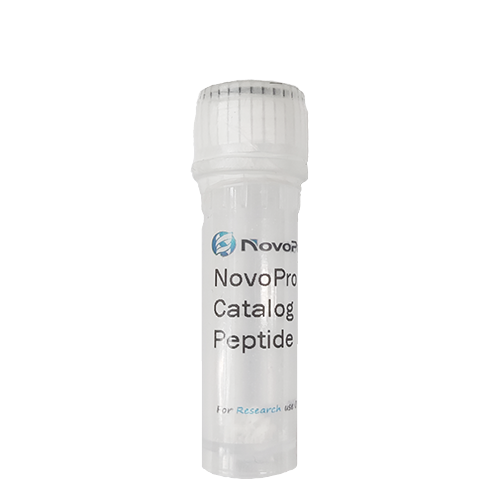Jelleine-I peptide
Not For Human Use, Lab Use Only.
Cat.#: 300529
Special Price 121.40 USD
-
Product Name
Jelleine-I peptide
-
Documents
Batch to batch variation of the purity
-
Sequence Shortening
PFKLSLHL-NH2
-
Sequence
Pro-Phe-Lys-Leu-Ser-Leu-His-Leu-NH2
-
Length (aa)
8
-
Peptide Purity (HPLC)
99.46%
-
Molecular Formula
C47H76N12O9
-
Molecular Weight
953.17
-
Source
Synthetic
-
Form
Powder
-
Description
Active against G+ bacteria S. aureus ATCC 6535, S. saprophyticus, B. subtilis CCT 2471 (MIC 10-15 ug/ml), and G- bacteria E. coli CCT 1371 (MIC 2.5 ug/ml), E. cloacae ACCT 23355, K. pneumoniae ACCT 13883, P. aeruginsa ACCT 27853 (MIC 10 ug/ml), and yeast C. albicans (MIC 2.5 ug/ml). Jelleines are produced constitutively by the workers and secreted into Royal Jelly. This peptide can show synergistic killing of Gram-positive bacteria with temporin A or B (Romanelli A et al 2011 Peptides Jan 19. doi: 10.1002/psc.1316). Updated Jan 2011; 7/2014. Jelleine-I has Antibacterial, Antifungal activity. The source of Jelleine-I is honeybees, Apis mellifera.
-
Storage Guidelines
Normally, this peptide will be delivered in lyophilized form and should be stored in a freezer at or below -20 °C. For more details, please refer to the manual: Handling and Storage of Synthetic Peptides
-
References
- Fontana R, Mendes MA, De souza BM, et al. Jelleines: a family of antimicrobial peptides from the Royal Jelly of honeybees (Apis mellifera). Peptides. 2004;25(6):919-28.
-
About TFA salt
Trifluoroacetic acid (TFA) is a common counterion from the purification process using High-Performance Liquid Chromatography (HPLC). The presence of TFA can affect the peptide's net weight, appearance, and solubility.
Impact on Net Weight: The TFA salt contributes to the total mass of the product. In most cases, the peptide content constitutes >80% of the total weight, with TFA accounting for the remainder.
Solubility: TFA salts generally enhance the solubility of peptides in aqueous solutions.
In Biological Assays: For most standard in vitro assays, the residual TFA levels do not cause interference. However, for highly sensitive cellular or biochemical studies, please be aware of its presence.
-
Molar Concentration Calculator
-
Dilution Calculator
-
Percent Concentration Calculator
Mass (g) = Concentration (mol/L) × Volume (L) × Molecular Weight (g/mol)
Related Products / Services
• Peptide Services: NovoPro's peptide synthesis services include standard chemical peptide synthesis, peptide modification, peptide libraries, and recombinant peptide expression.
• Standard Peptide Synthesis: NovoPro offers quality peptides at the most competitive prices in the industry, starting at $3.20 per amino acid. NovoPro provides PepBox – Automatic Quote Tool for online price calculation.
• Peptide Modifications: NovoPro offers a wide range of peptide modification services including isotope labeling (2H, 15N, and 13C), multiple disulfide bonds, multiple phosphorylations, KLH, BSA, ovalbumin, amidation, acetylation, biotin, FITC, etc.
Please note: All products are "FOR RESEARCH USE ONLY AND ARE NOT INTENDED FOR DIAGNOSTIC OR THERAPEUTIC USE"

